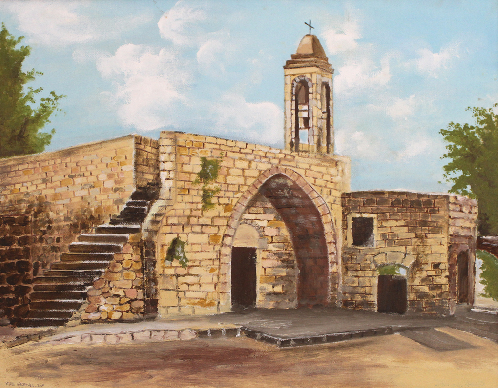
Preliminary note
Kafar Bir’em is an Arab Christian village in the Galilee. The Israeli forces entered the village late in October 1948, and in the middle of November of the same year the inhabitants of the village were given orders to leave it for twoweeks.To this day they are still uprooted and scattered in their homeland. In 1953 their land was confiscated and the village was destroyed by the Israeli authorities, which continued to deny the right of return of Kefar Bir’em indigenous and uprooted population to their land and village.Introduction
Kafar Bir’em was a small village located in the North Central Upper Galilee, four kilometers south of the Lebanese-Israeli borders. Its Arab Christian population cultivated the fields, tilled the land and subsisted from its bounties. For four-hundred years during the Ottoman rule and for twenty-nine years of the British Mandate the villagers lived in peace and harmony with their neighbors.When the Israeli forces occupied the village on 29 October 1948, the inhabitants decided to stay in their homes and continue with their normal life. However, one week later, on 7 November 1948, two officers from the Israeli Ministry of MinorityAffairs arrived to the village and conducted a census of the village’s population. Every single person in the village who was present that day had been registered as a citizen of the new State.
Three weeks after the occupation of the village, i.e. two weeks after the census,the villagers were given orders to leave the village temporarily in the presence of the Minister of Minority Affairs while officially ensuring their return in two weeks. The inhabitants departed from their village to the neighboring Gishvillage.
In spite of the repeated promises made by the Israeli government and officials including the first Israeli Prime Minister, the Minister of Police and Minority Affairs, and Christian Affairs Advisor, the uprooted inhabitants of Kefar Bir’em could not return to the village. As months passed, it became evident that the Israeli government had no intention to allow Kefar Bir’em inhabitants to return to their village and that the promises made by government officials would never hit the bull’s eye.
In their capacity as citizens of the State of Israel, the uprooted population of Kefar Bir’em lodged a lawsuit at the High Court of Justice in 1951 in an attempt to redeem their rights, but the governmentclaimed the area in which the village was located was a“closed military zone.” In addition, the government issued a declaration whereby the illegal closure ofthe village wassubsequently legalized. In November 1951 the Israeli government issued orders requesting Kafar Bir’em inhabitants to leave the “closed military zone,” noting that they had been previously notified to leave the village on 20 November 1948 with an official promise and commitment from the Israeli authorities to return to it in two weeks. The decision issued by the Court on 18 January 1952 stated that “in order to be able to return to their village, the claimants- need to obtain a special permit from the military governor.” But the military governor had not issued any such a permit to date.
In August 1953 the Israeli government confiscated the land of Kafar Bir’em and allocated part of it to the construction of new Israeli settlements. The following month, on 16-17 September, the Israeli military forces bombedthe villageand decimated it with dynamite as its inhabitants stood watching with sorrowful eyes from a location that came to be known later by the name of “Al-Mabka” (Place of Lament) near the neighboring Gish village.
The inhabitants of Kafar Bir’em hope that one day the promise of return given to them more than six decades ago will be carried out. During all those years they have been appealing for their return. The successive Israeli governments looked into the appeal and none denied the right of return of Kafar Bir’em population to their village, homes and land. On the other hand, none of the Israeli governments took a decision allowing for the return of Kafar Bir’em population to their village, and to this day the candle of hope for return remains radiating and bright.